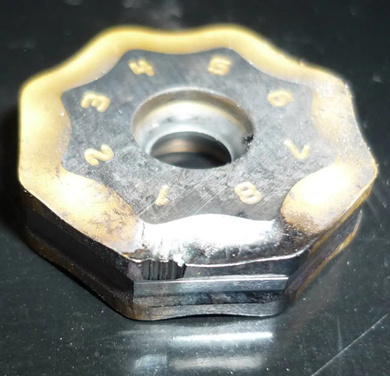Having been in the machining industry for many years, you must be no stranger to tool failure.Tool failure will affect machining accuracy and productivity, operator safety, and part quality.When tool breakage is observed, the machining process should be carefully analyzed in time to find the root cause.
Flank wear
Flank wear refers to the abrasion loss of the flank of the tool immediately below the cutting edge. The carbide particles in the workpiece material or the work-hardened material rubs against the blade. Small pieces of the coating peel off and the blade rubs. The cobalt element in the blade is finally separated from the crystal lattice, reducing the adhesion of the cemented carbide and thus peeling off.

Relatively uniform wear along the cutting edge. Sometimes flaking work material sticks to the cutting edge, making the wear look exaggerated than it actually is. Duratomic blades are black when worn, while the wear of ordinary blades is shiny. The black color is the bottom coating that is displayed after the surface coating is peeled off.

Crumble
Flank chipping
Ⅰ
Flank chipping refers to a mechanical failure that occurs when small particles on the cutting edge are peeled off instead of being worn away by the flank. Flank face spalling occurs when there is an impact load change, such as intermittent cutting. Flank chipping is often the result of unstable workpiece conditions, such as when the tool is too long or the workpiece is under-supported. The secondary cutting of chips is also easy to cause chipping. Rake face peeling.
Ⅱ
Viscous materials will spring back after cutting. This springback may exceed the clearance angle of the tool and create friction between the clearance surface of the tool and the workpiece. This friction will cause a polishing effect and may cause work hardening of the workpiece. It will increase the contact between the tool and the workpiece, which will cause heat to cause thermal expansion, leading to expansion of the rake face, and chipping of the rake face.
Rake area edge
Certain workpiece materials may create a rake area between the chip and the cutting edge. When the continuous lamination of the workpiece material is connected to the cutting edge, built-up edge will occur. The built-up tumor is a dynamic structure. During the cutting process, the cut surface of the built-up edge continuously peeled off and reattached.

The cutting edge of the rake area also tends to occur at low processing temperatures and relatively slow cutting speeds. The actual speed at which a cutting edge occurs in the rake area depends on the material being processed. If the work hardening material is processed, such as austenitic stainless steel, then the cutting edge area of ??the rake can cause rapid accumulation at the depth of cut, resulting in a secondary failure mode of damage at the depth of cut.
TAG: Tool breakage, tool chipping,flank chipping,rake area edge 



